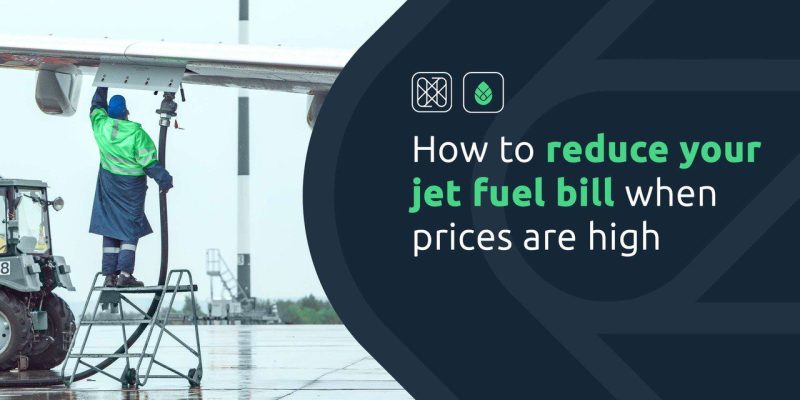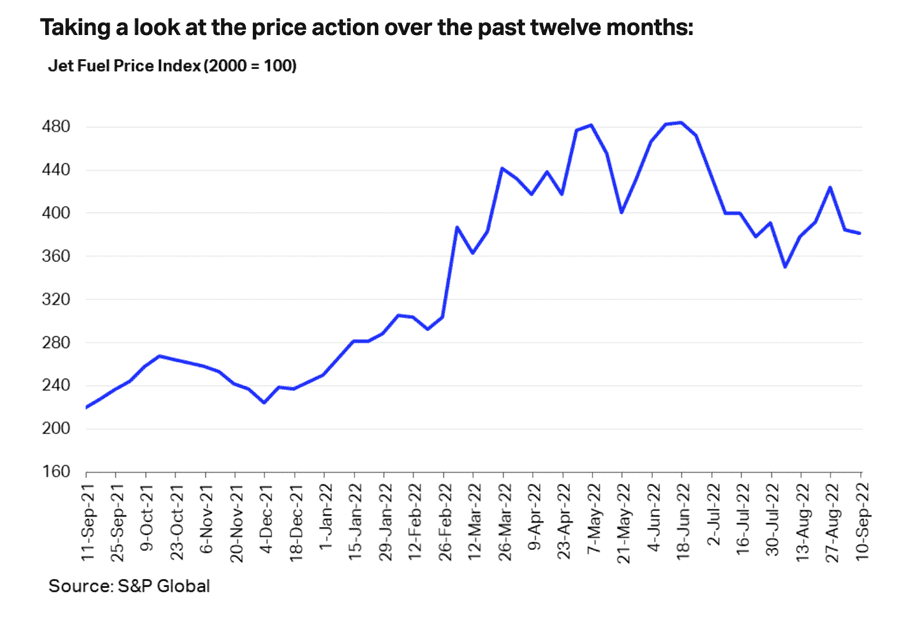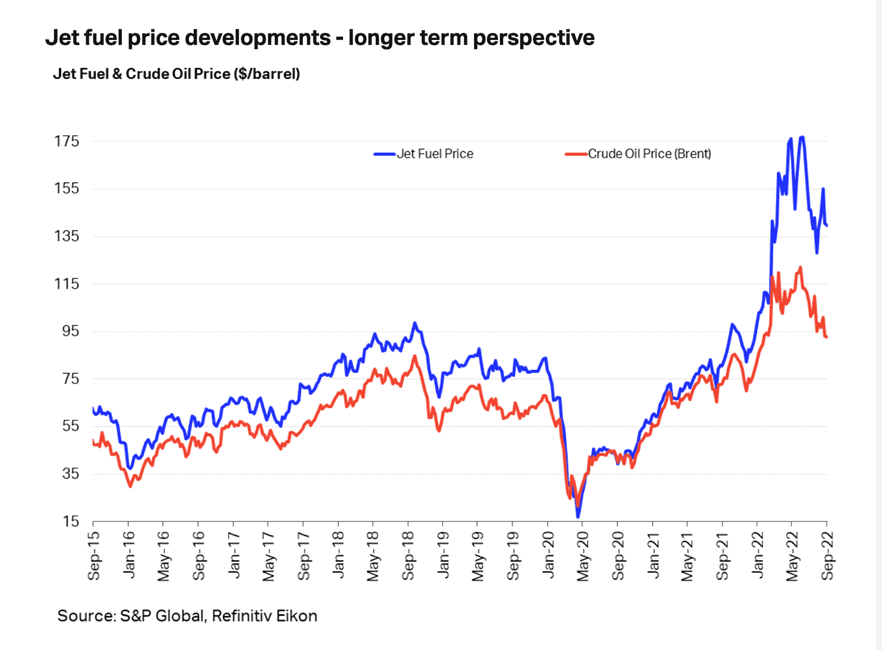

Jet fuel prices have remained stubbornly high in 2022 as these graphs from IATA’s jet fuel monitor illustrate:



Caused by a combination of factors — the war in Ukraine, reduced refining capacity after the pandemic, and the sudden increase in demand for flights — it’s likely that jet fuel prices will continue to stay high this year and into next.
Many airlines assume they can’t reduce their fuel bill without reducing fuel consumption, but that’s not so. By managing your fuel well so that overspend and wastage are kept to a minimum, you can keep costs down. So, how do you do this?
Good fuel planning
It all begins with good fuel planning. Clearly your fuel volume forecast needs to be as accurate as possible because all your other decisions are going to be based on this data, including your budget and your purchasing strategy.
Relying solely on standard schedules and theoretical aircraft consumption data won’t give you a very accurate fuel volume forecast. Instead, it’s better to use a fuel management system that can take statistical fuel data from your previous flights and combine that with information from these other sources. It could mean a variance (between what you forecasted and what you actually used) that is <1% as opposed to 20%*; this represents a significant saving.
A fuel management system that lets you test out different scenarios at the fuel planning and budgeting stage can make a real difference too. This would allow you to see how changes in for example, types of aircraft, locations, and days of operation, would affect volumes, or how different exchange rates and contract prices would affect the fuel bill. Being able to see and evaluate different scenarios in advance, empowers you to make better decisions for your airline.
Good fuel procurement
Negotiating the right amount of fuel at the right price is essential to keeping costs down. We’ve covered calculating the right amount (fuel volume forecasts), so this step is about turning that into accurate tender documents and choosing the supplier bids that represent the best value.
If you can, use a fuel management system that automatically translates volume forecasts into tender documents. This will save you time and should avoid any data entry slip-ups that could increase your fuel bill.
When you are evaluating the bids, don’t be tripped up by different formats and pricing structures. You need to ‘normalize’ them to ensure you are comparing like-with-like, so a tool that can do this automatically is a big help. This will enable you to make the best decision for your airline and agree fuel contracts that represent good value.
At the fuel procurement stage, airlines can overspend by up to 2% but the good news is that with these improvements, you could reduce that to 0.05%*.
Good fuel operations monitoring
Effective fuel management doesn’t stop at the procurement stage; your airline needs to continuously monitor your flight and fuel events and the associated costs. This is so you can keep an eye on the variance between the fuel usage and spend you forecasted, and what’s actually happening. It will also help ensure your airline meets its contractual obligations — for example, if you have promised a certain volume to a supplier. Noticing any issues early will allow you to address these quickly, so you can avoid penalties and limit overspend.
Fuel management systems can make this stage a breeze. They can automatically capture fuel uplifts, link them with flight events, and calculate costs using fuel price indexes and other terms set out in agreed contracts.
Good fuel accounting
To keep your airline’s jet fuel bill down, you also need to ensure that the fuel invoices you receive are accurate. It’s surprisingly common for airlines to receive invoices that are incorrect — because of a discrepancy in volume or product/differential price, or sometimes because the flight never actually happened! In fact, we’ve found that overspend at this stage alone can be up to 5% of a carrier’s total fuel budget*.
However, you can reduce any overspend to near-zero with a good fuel management system. It can automatically check invoice amounts against the fuel ticket; the flight data from the aircraft; and the contract prices, taxes, and surcharges. It would be impossible to do this manually for every flight, but it’s easy when you have fuel management software that does it for you.
On top of that, if you have a fuel management system that can part-pay invoices — rejecting only the incorrect lines on the invoice and settling the others — you will be able to improve payment times and so avoid penalties or increased differentials from your fuel suppliers.
Good emissions management
You might not expect emissions management to be in this blog; it isn’t an obvious area of cost leakage. However, now that 599 aircraft operators+ have signed up to offset their emissions through CORSIA, it’s one of growing importance. We have calculated that the potential financial impact of carbon offsets by 2035, could be as much as 25% of a carrier’s operating profit^. So make no mistake: being able to accurately forecast and track your emissions, does have an impact on your bottom line.
At the fuel planning stage, you need to forecast your emissions as accurately as possible and budget for carbon offsets. Again, if you can use statistical emissions data from previous flights here, it will really help improve the accuracy of your forecast.
To then track your emissions accurately and ensure you pay for the right number of offsets, you need accurate fuel consumption data. Our advice is to collect actual consumption data — not simplified averages — at a very granular level and from various sources, such as fuel invoices, fuel tickets, ACARS, loading sheet data etc.
This not only improves accuracy; it also means you have all the data you need to calculate emissions using any of CORSIA’s five methods. This gives you a choice about which calculation method to use, which could potentially reduce your offsets bill.
*Average percentages are based on analysis of our customer data.
+ Source: CORSIA Newsletter August 2022.
^ Source: FuelPlus Emissions Management webinar. This is based on a high carbon price of 33 EUR/ton CO2-eq and revenue examples taken from several group carriers in EMEA.
Good data management and process efficiency
As you can see, good fuel management — from planning right through to accounting and emissions tracking — relies on your airline having reliable, granular data and efficient processes. A best-in-class fuel management platform can give you this. It will centralize and link all your fuel and flight data. It will collect and verify this data automatically, so that accuracy improves, and tasks take less time — tasks such as creating fuel volume forecasts and budgets, issuing tenders, evaluating and awarding bids, and checking invoices.
This is what Skymetrix offers: the ability to get total control over every aspect of your fuel operations, so you can drive out inefficiencies, eliminate overspend and ultimately, reduce your fuel bill. We can reduce an airline’s overspend on fuel to <0.5%, down from an average of 2–3%*. And when you do the math, that’s a saving worth having — especially when fuel prices are as high as they are currently.
Find out more about our fuel solutions and start getting more control over your fuel bill.



